Kenmore 795.75219.402, 795.75214.402, 795.75212.402, 795.75209.402, 795.75204.402 Service Manual
...
TM
REFRIGERATOR
SERVICE MANUAL
CAUTION
BEFORE SERVICING THE UNIT,
READ THE SAFETY PRECAUTIONS IN THIS MANUAL.
MODELS:
795.75002.402
795.75004.402
795.75009.402
795.75012.402
795.75014.402
795.75019.402
795.75202.402
795.75204.402
795.75209.402
795.75212.402
795.75214.402
795.75219.402

CONTENTS
SAFETY PRECAUTIONS |
………………………………………………………………. 2 |
|
1. |
SPECIFICATIONS |
………………………………………………………………. 3 |
2. |
PARTS IDENTIFICATION |
………………………………………………………………. 4 |
3. |
DISASSEMBLY |
………………………………………………………………. 6 |
4. ADJUSTMENT |
………………………………………………………………. 8 |
|
5. CIRCUIT DIAGRAM |
……………………………………………………………….10 |
|
6. TROUBLESHOOTING |
……………………………………………………………….12 |
|
7. OPERATION PRINCIPLE AND REPAIR METHOD OF ICEMAKER |
……………………………………………………………….18 |
|
8. DESCRIPTION OF FUNCTION & CIRCUIT OF MICOM |
……………………………………………………………….22 |
|
9. EXPLODED VIEW & REPLACEMENT PARTS LIST |
……………………………………………………………….42 |
|
SAFETY PRECAUTIONS
Please read the following instructions before servicing your refrigerator.
1.Check the refrigerator for electrical faults.
2.To prevent electric shock, unplug before servicing.
3.Always check line voltage and amperage.
4.Use standard electrical components.
5.Don't touch metal products in the freezer with wet hands. This may cause frostbite or cause your skin to freeze and stick to the surfaces inside the freezer.
6.Prevent water from flowing onto electric elements in the mechanical parts.
7.Close the top door before opening the bottom door. Otherwise, you might hit your head when you stand up.
8.When tilting the refrigerator, remove any materials on the refrigerator, especially the glass shelves and stored foods.
9.When servicing the evaporator, wear cotton gloves. This is to prevent injuries from the sharp evaporator fins.
10.Disassembly, repair, and servicing the sealed refrigeration system should be performed only by qualified and certified personnel. Refrigerant should not be vented into the atmosphere; proper recovery equipment should be used.
- 2-
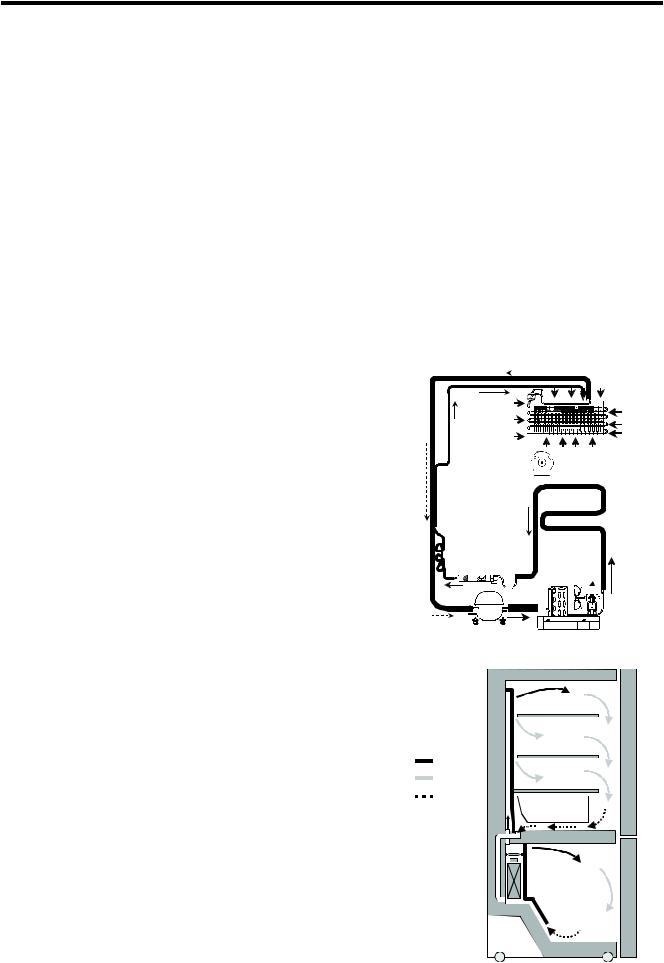
1. SPECIFICATIONS
1-1 DISCONNECT POWER CORD BEFORE
SERVICING
IMPORTANT RECONNECT ALL
GROUNDING DEVICES
All parts of this appliance capable of conducting electrical current are grounded. If grounding wires, screws, straps, clips, nuts or washers used to complete a path to ground are removed for service, they must be returned to their original position and properly fastened.
1-2 IMPORTANT NOTICE
This information is intended for use by individuals possessing adequate backgrounds of electrical, electronic and mechanical experience. Any attempt to repair a major appliance may result in personal injury and property damage. The manufacturer or seller cannot be responsible for the interpretation of this information, nor can it assume any liability in connection with its use.
1-7 REPLACEMENT PARTS
Relay............................................................. |
6749C-0008D |
Overload ....................................................... |
6750C-0004S |
Defrost Thermostat...................................... |
6615JB2005C |
Defrost Heater.............................. |
20cu. ft : 5300JB1100D |
............................... |
22cu. ft : 5300JB1100J |
Evaporator Fan Motor.................................. |
4680JK1002B |
Capacitor .................................................... |
OCZZJB2012J |
Compressor (Hi-Side).................................. |
2521CRA5715 |
Evaporator (Lo-Side)..................... |
20cu. ft : 5421JJ1001A |
..................... |
22cu. ft : 5421JJ1001B |
Condenser ............................................... |
5403JJ1007A |
Dryer ............................................................. |
5851JJ2002B |
Condenser Fan Motor .................................. |
4680JK1001B |
Temperature Control............................. |
6871JB2047A |
Main Control........................................... |
6871JB1215F |
1-3 ELECTRICAL SPECIFICATIONS
Temperature Control (Position : MID) |
........................ 8-(-6)°F |
|
Defrost Control.............................................................. |
|
Automatic. |
Defrost Thermostat......................................................... |
50°F |
|
Electrical Rating :115V. AC, 60 Hz........................... |
1-5 Amp. |
|
Maximum Current Leakage......................................... |
0.5 mA |
|
Maximum Ground Path Resistance...................... |
0.14 Ohms |
|
Energy Consumption.. |
|
|
520kWh/yr (meet DOE) |
530kWh/yr (meet DOE) |
|
795.75004.402 |
795.75204.402 |
|
795.75002.402 |
795.75202.402 |
|
795.75009.402 |
795.75209.402 |
|
795.75014.402 |
795.75214.402 |
|
795.75012.402 |
795.75212.402 |
|
795.75019.402 |
795.75219.402 |
|
1-4 NO LOAD PERFORMANCE
CONTROL POSITION: MID/MID
And Ambient of :......................... |
70°F.......................... |
90°F |
Fresh Food, °F.............. |
33°F to 41°F............. |
33°F to 41°F |
Frozen Food, °F............ |
(-4°F) to 4°F............. |
(-4°F) to 4°F |
Percent RunningTime ....... |
25%-35%................. |
45%-60% |
|
PERFORMANCE DATA |
|
||
(NORMAL OPERATING CONDITIONS) |
||||
AMB |
WATTS |
SYSTEM PRESSURE (PSIG) |
||
HIGH SIDE |
|
LOW SIDE |
||
|
|
|
||
70°F |
98 (+10 / -10) |
97 (+5 / -3) |
|
(-5) to (-2) |
90°F |
98 (+10 / -10) |
130 (+3 / -3) |
|
(-4) to 1 |
110°F |
103 (+5 / -5) |
174 (+5 / -5) |
|
(-2) to 3 |
|
|
|
|
|
1-5 REFRIGERATION SYSTEM |
|
|||
Minimum Compressor Capacity Vacuum ................... |
21 in. |
|||
Minimum Equalized Pressure |
|
|||
@ 70°F ....................................................... |
|
|
49 PSIG |
|
@ 90°F ....................................................... |
|
|
56 PSIG |
|
Refrigerant - R - 134a ............................................. |
|
|
4.2 Oz |
|
Compressor ...................................................... |
|
|
700 BTU/hr |
|
1-6 INSTALLATION
Clearance must be provided at top, sides and rear of the
refrigerator for air circulation. |
1 in |
AT TOP ........................................................................ |
|
AT SIDES ................................................................... |
1/8 in |
AT REAR ...................................................................... |
1 in |
1-8 AIR FLOW / CIRCULATION D' AIR
EVAPORATOR
EVAPORATOR FAN 
HOT LOOP
DRYER
 CONDENSER FAN
CONDENSER FAN
COMPRESSOR CONDENSER
21cu.ft............................................ |
5.47 oz. |
FRESH FOOD
COLD AIR
MIXED AIR
AIR RETURN TO
EVAPORATOR
Vegetable box
EVAPORATOR
FREEZER
- 3-

2. PARTS IDENTIFICATION
Freezer Drawer Model
Cool sense
Electronic
Temperature
Control system
Refrigerator Light
Refrigerator Shelves
Egg Box
Snack Pan
Super Fresh Crisper with Tilt-out Compartment
Keeps fruits and
vegetable fresh
and crisp
Adjust cube
Icemaker
Ice Bin
Durabase
Divider
Dairy Corner
Modular
Door Bin
Refrigerator
Door Rack
Freezer Light
Glide-Out
Drawer Basket
- 4 -

Swing Out Freezer Door Model
Cool sense |
Electronic |
Temperature |
Control system |
Refrigerator Light |
Refrigerator Shelves |
Snack Pan |
Super Fresh Crisper |
with Tilt-out |
Compartment |
Keeps fruits and |
vegetable fresh |
and crisp |
Ice Maker |
Ice Bin |
Durabase |
Base Grille |
Dairy Corner
Modular
Door Bin
Refrigerator
Door Rack
Freezer Light
Freezer Door
Rack
Glide-Out
Drawer Basket
- 5 -
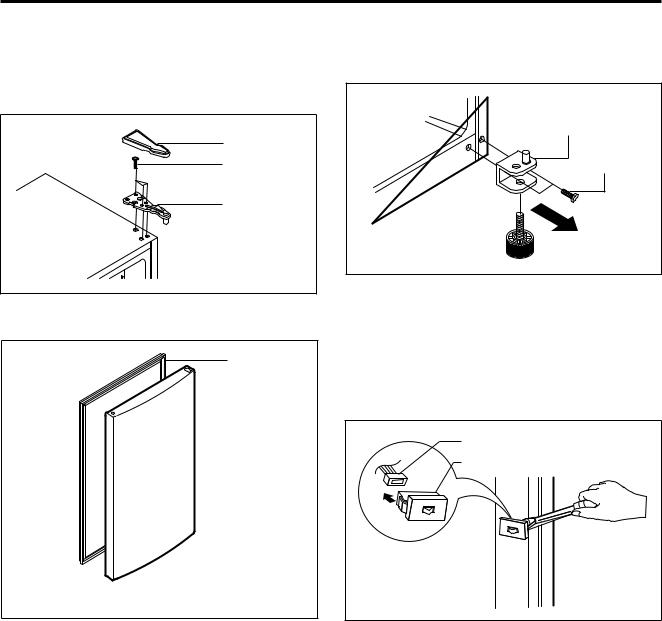
3. DISASSEMBLY
3-1 DOOR
Refrigerator Door
1.Remove the hinge cover by pulling it upwards.
2.Loosen the hexagonal bolts attaching the upper hinge to the body and lift the freezer door.
HINGE COVER
BOLT
HINGE
Figure 1
3.Pull out the door gasket to remove from the door foam assembly.
GASKET
Figure 2
Freezer Door
1.Loosen the hexagonal bolts attaching the lower hinge to the body to remove the refrigerator door only.
LOWER HINGE
BOLT
Figure 3
2.Pull out the door gasket to remove from the door foam assembly.
3-2 DOOR SWITCH
1.To remove the door switch, pry it out with a slotted-type driver, as shown in (Figure 4).
2.Disconnect the lead wire from the switch.
LEAD WIRE
DOOR SWITCH
Figure 4
- 6 -
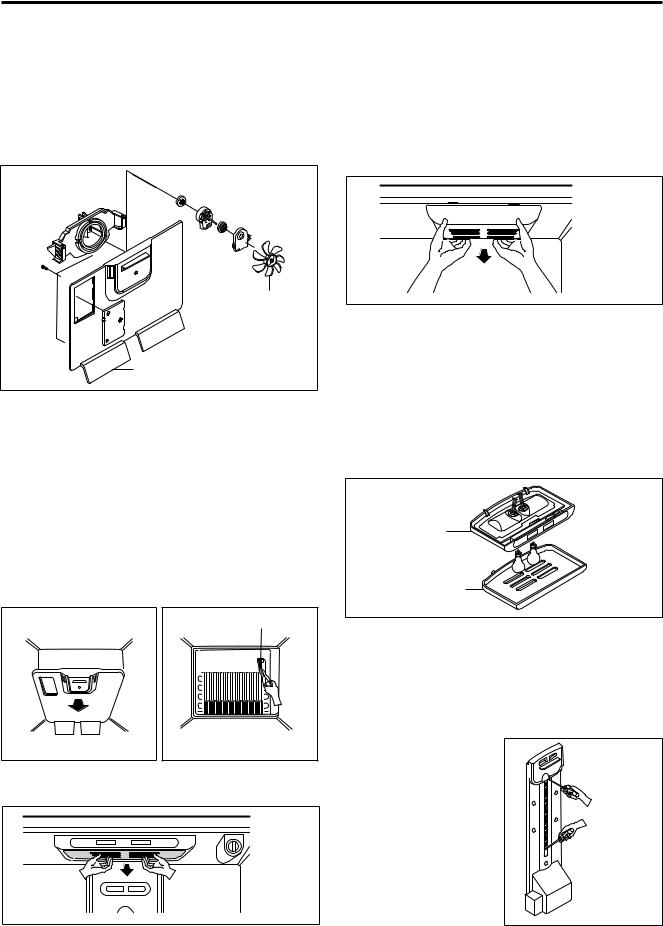
3-3 FAN AND FAN MOTOR
1.Remove the freezer shelf. (If your refrigerator has an icemaker, remove the icemaker first)
2.Remove the grille by pulling it out and by loosening a screw.
3.Remove the Fan Motor assembly by loosening 2 screws and disassemble the shroud.
4.Pull out the fan and separate the Fan Motor and Bracket.
BRACKET |
FAN MOTOR |
|||
MOTOR |
||||
|
|
|||
|
|
|
|
|
|
|
|
|
|
FAN
GRILLE |
Figure 5 |
3-4 DEFROST CONTROL ASSEMBLY
Defrost Control assembly consists of Defrost Sensor and FUSE–M.
The Defrost Sensor works to defrost automatically. It is attached to the metal side of the Evaporator and senses its temperature. At 72°C, it turns the Defrost Heater off.
Fuse-M is a safety device for preventing over-heating of the Heater when defrosting.
1.Pull out the grille assembly. (Figure 6)
2.Separate the connector with the Defrost Control assembly and replace the Defrost Control assembly after cutting the Tie Wrap. (Figure 7)
GRILLE ASSEMBLY |
DEFROST-CONTROL |
|||||||||||||||||||
|
|
|
|
|
|
ASSEMBLY |
||||||||||||||
|
|
|
|
|
|
|
|
|
|
|
|
|
|
|
|
|
|
|
|
|
|
|
|
|
|
|
|
|
|
|
|
|
|
|
|
|
|
|
|
|
|
|
|
|
|
|
|
|
|
|
|
|
|
|
|
|
|
|
|
|
|
|
|
|
|
|
|
|
|
|
|
|
|
|
|
|
|
|
|
|
|
|
|
|
|
|
|
|
|
|
|
|
|
|
|
|
|
|
|
|
|
|
|
|
|
|
|
|
|
|
|
|
|
|
|
|
|
|
|
|
|
|
|
|
|
|
|
|
|
|
|
|
|
|
|
|
|
|
|
|
|
|
|
|
|
|
|
|
|
|
|
|
|
|
|
|
|
|
|
|
|
|
|
|
|
|
|
|
|
|
|
|
|
|
|
|
|
|
|
|
|
|
|
|
|
|
|
|
|
|
|
|
|
|
|
|
|
|
|
|
|
|
|
|
|
|
|
|
|
Figure 6 |
Figure 7 |
3-5 LAMP
Figure 8
3-5-1 Refrigerator Compartment Lamp
1.Unplug the power cord from the outlet.
2.Remove refrigerator shelves.
3.Release the hooks on both ends of the lamp shield and pull the shield downward to remove it.
4.Turn the lamp counterclockwise.
5.Assemble in reverse order of disassembly. Replacement bulb must be the same specification as the original (Max. 60 W-2EA).
Figure 9
3-5-2 Freezer Compartment Lamp
1.Unplug refrigerator or disconnect power.
2.Reach behind light shield to remove bulb.
3.Replace bulb with a 40-watt appliance bulb.
4.Plug in refrigerator or reconnect power.
3-6 CONTROL BOX-REFRIGERATOR
1.First, remove all shelves in the refrigerator, than remove the Refrigerator control Box by loosening 2 screws.
CONTROL BOX
COVER LAMP
Figure 10
2.Remove the Refrigerator Control Box by pulling it downward.
3.Disconnect the lead wire on the right position and separate the lamp sockets.
3-7 MULTI DUCT
1. Remove an upper and lower Cap by using a flat screwdriver, and loosen 3 screws. (Figure 11)
2. Disconnect the lead wire on the bottom position.
Figure 11
- 7 -
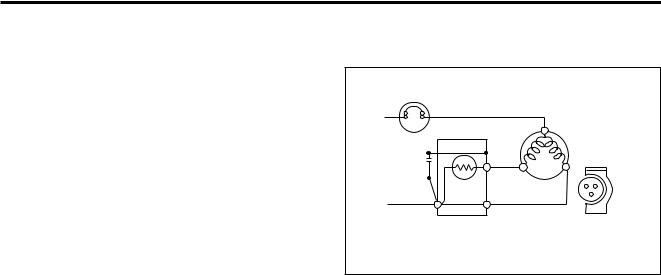
4. ADJUSTMENT
4-1 COMPRESSOR
4-1-1 Role
The compressor intakes low temperature and low pressure gas from the evaporator of the redrigerator and compresses this gas to high-temperature and high-pressure gas. It then delivers the gas to the condenser.
4-1-2 Composition
The compressor includes overload protection. The PTC starter and OLP (overload protector) are attached to the outside of the compressor. Since the compressor is manufactured to tolerances of 1 micron and is hermetically sealed in a dust and moisture-free environment, use extreme caution when repairing it.
4-1-3 Note for Usage
(1)Be careful not to allow over-voltage and over-current.
(2)If compressor is dropped or handled carelessly, poor operation and noise may result.
(3)Use poper electric components appropriate to the Particular Compressor in your product.
(4)Keep Compressor dry.
If the Compressor gets wet (in the rain or a damp environment) and rust forms in the pin of the Hermetic Terminal, poor operation and contact may result.
(5)When replacing the Compressor, be careful that dust, humidity, and soldering flux don’t contaminate the inside of the compressor. Dust, humidity, and solder flux contaminate the cylinder and may cause noise, improper operation or even cause it to lock up.
4-2 PTC.STARTER
4-2-1 Composition of PTC-Starter
(1)PTC (Positive Temperature Coefficient) is a no-contact semiconductor starting device which uses ceramic material consisting of BaTiO3.
(2)The higher the temperature is, the higher the resistance value. These features are used as a starting device for the Motor.
4-2-2 Role of PTC-Starter
(1)The PTC is attached to the Sealed Compressor and is used for starting the Motor
(2)The compressor is a single-phase induction motor. During the starting operation, the PTC allows current flow to both the start winding and main wiinding
4-2-3 PTC-Applied Circuit Diagram |
|
|
|
Starting Method for the Motor |
|
|
|
OVERLOAD PROTECTOR |
|
|
|
N |
C |
|
|
|
|
|
|
PTC |
5 |
COMPRESSOR |
|
2 |
MOTOR |
|
|
|
|
|
|
|
S |
M |
M |
3 |
6 |
S |
|
L1 |
|
|
|
PTC STARTER |
SEALED |
|
|
Resistance Starter Capacitor Running |
TERMINAL |
||
|
|
||
Figure 12
4-2-4 Motor Restarting and PTC Cooling
(1)It requires approximately 5 minutes for the pressure to equalize before the compressor can restart.
(2)The PTC device generates heat during operation. Therefore, it must be allowed to cool before the compressor can restart.
4-2-5 Relation of PTC-Starter and OLP
(1)If the compressor attempts to restart before the PTC device is cooled, the PTC device will allow current to flow only to the main winding.
(2)The OLP will open because of the over current condition. This same process will continue (3 to 5 times) when the compressor attempts to restart until the PTC device has cooled. The correct OLP must be properly attached to prevent damage to the compressor.
Parts may appear physically identical but could have different electrical ratings. Replace parts by part number and model number. Using an incorrect part could result in damage to the product, fire, injury, or possibility death.
4-2-6 Note for Using the PTC-Starter
(1)Be careful not to allow over-voltage and over-current.
(2)Do not drop or handle carelessly.
(3)Keep away from any liquid.
If liquid such as oil or water enters the PTC, PTC materials may fail due to breakdown of their insulating capabilities.
(4)If the exterior of the PTC is damaged, the resitance value may be altered. This can cause damage to the compressor and result inn a no-start or hard-to-start condition.
(5)Always use the PTC designed for the compressor and make sure it is properly attached to the compressor. Parts may appear physically identical but could have different electrical ratings. Replace parts by part number and model number. Using an incorrect part could result in damage to the product, fire, injury, or possibly death.
- 8 -

4-3 OLP (OVERLOAD PROTECTOR)
4-3-1 Definition of OLP
(1)OLP (OVERLOAD PROTECTOR) is attached to the Compressor and protects the Motor by opening the circuit to the Motor if the temperature rises and activating the bimetal spring in the OLP.
(2)When high current flows to the Compressor motor, the Bimetal works by heating the heater inside the OLP, and the OLP protects the Motor by cutting off the current flowing to the Compressor Motor.
4-3-2 Role of the OLP
(1)The OLP is attached to the Sealed Compressor used for the Refrigerator. It prevents the Motor Coil from being started in the Compressor.
(2)For normal operation of the OLP, do not turn the Adjust Screw of the OLP in any way.
(OVERLOAD PROTECTOR cross section)
|
|
Customer part |
|
12345678 |
number |
|
Lot code/ |
|
|
|
|
330 FBYY |
-S1 BOX98 |
date code |
|
||
Electrical |
|
Physical |
characteristics |
|
termination |
part number |
|
part number |
Part
No. Name
 Base, phenolic (UL 94 V-0 rated)
Base, phenolic (UL 94 V-0 rated)
 Movable arm support, plated steel
Movable arm support, plated steel
Stationary contact support, plated steel
 Heater support, plated steel
Heater support, plated steel
Heater, resistance alloy
 Disc, thermostatic alloy
Disc, thermostatic alloy
Movable arm, spring temper copper alloy
 Contact, movable, silver on copper
Contact, movable, silver on copper
Contact, stationary, silver on copper
 Slug, plated steel
Slug, plated steel
Cover, polyester (UL 94 V -0 rated)
 Pin connector, plated copper alloy (To engage 2.33/2.66 mm dia. pin)
Pin connector, plated copper alloy (To engage 2.33/2.66 mm dia. pin)  Quick-connect terminal, brass, conforms to UL 310, MEMA
Quick-connect terminal, brass, conforms to UL 310, MEMA
DC-2, DIN 46344
Figure 13
4-4 TO REMOVE THE COVER PTC
(1)Remove the Cover Back M/C.
(2)Remove the screw on Cover PTC
1
(3)Remove two Housings on upper part of Cover PTC.
(4)Take out the cover PTC from upper to lower position like 1 .
 2
2
(5)Turn 45° in the direction of 2 and take it out.
(6)Assembly in reverse order of disassembly.
- 9 -
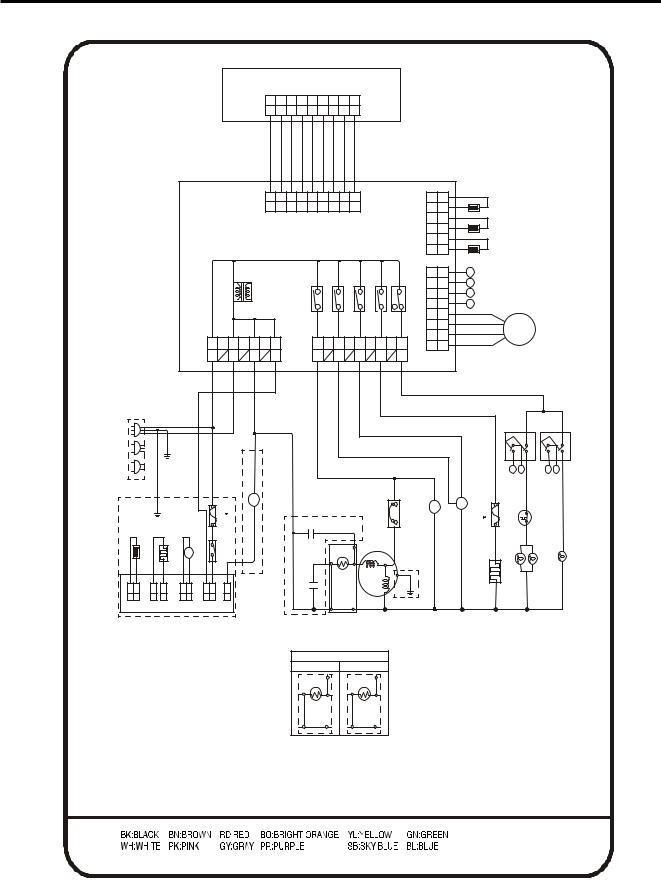
5. CIRCUIT DIAGRAM
PWB(PCB) ASSEMBLY,DISPLAY-R
CON101 |
8 |
7 |
6 |
5 |
4 |
3 |
2 |
1 |
9 |
BK BN RD BO BL GY YL WH PR
|
|
|
CON3 |
|
BK BN RD BO BL GY YL WH PR |
|
|
|
CON4 |
1 |
BL |
||||||||||
|
|
|
|
|
|
1 |
2 |
3 |
4 |
5 |
6 |
7 |
8 |
|
9 |
|
|
|
|
2 |
BL |
|
|
|
|
|
|
|
|
|
|
|
|
|
|
|
|
|
|
|
|
3 |
WH |
|
|
|
|
PWB(PCB) ASSEMBLY,MAIN |
|
|
|
4 |
WH |
||||||||||||
|
|
|
|
|
|
|
5 |
BO |
|||||||||||||
|
|
|
|
|
|
|
|
|
|
|
|
|
|
|
|
|
|
|
|
6 |
BO |
|
|
|
|
|
|
|
|
|
|
|
|
|
|
|
|
|
|
|
CON5 |
1 |
GY |
|
|
|
|
|
|
|
|
|
|
|
|
|
|
|
|
|
|
|
|
2 |
GY |
|
|
|
|
|
|
|
|
|
|
|
|
|
|
|
|
|
|
|
|
3 |
PK |
|
|
|
|
|
|
|
|
|
|
|
|
|
|
|
|
|
|
|
|
4 |
PK |
|
|
|
|
|
|
|
|
|
|
|
|
|
|
|
|
|
|
|
|
5 |
BL |
|
|
|
|
|
|
|
|
|
|
|
|
|
|
|
|
|
|
|
|
6 |
BK |
7 |
6 |
5 |
4 |
3 |
2 |
1 |
|
|
|
|
1 |
2 |
3 |
4 |
5 |
6 |
7 |
8 |
9 |
7 |
YL |
|
|
|
|
8 |
RD |
||||||||||||||||
CON1 YL |
|
BL |
|
BL |
|
BL |
|
|
|
BK |
PK |
|
GY |
BN |
|
SB CON2 |
|
|
|||
YL |
BL |
BL |
BL |
|
|
|
BK |
|
PK |
|
GY |
BN |
|
SB |
|
|
|||||
POWER
SUPPLY
CORD
|
|
|
L |
|
|
|
|
|
|
|
|
|
|
|
|
|
|
|
|
|
|
|
|
|
N |
|
|
GN/YL |
|
|
|
|
|
|
|
|
|
|
|
|
|
|
|
|
|
|
|
|
|
|
|
|
|
|
|
|
|
|
|
|
|
|
|
||
|
|
|
|
|
|
(GN) |
|
|
|
|
|
|
BL |
|
|
|
|
|
|
|
|
|
|
|
|
|
|
|
|
|
|
|
|
|
|
|
|
|
|
|
|
|
|
|
|
|
|
|
|
|
|
BL |
|
YL |
|
|
|
|
|
|
|
|
|
|
|
|
|
|
|
|
|
|
|
|
|
|
|
|
|
|
|
|
|
|
|
|
HIGH |
|
|
|
|
|
|
|
|
|
|
|
|
|
|
|
|
|
|
|
|
|
BK |
|
|
|
|
|
|
|
|
|
|
|
|
|
|
V |
PART |
|
|
|
|
PROTECTOR |
|
|
|
|
|
|
|
|
|
|
|
|
BK |
M-FUSE |
(98C) |
|
VALVEWATER |
|
|
|
LOADOVER |
FAN- |
|
|
|
|
|
|
GN/YL |
|
|
|
|
|
|
|
|
|
CAPACITOR PART |
|
|
|
|
M |
|
|
|
|
|
|
(GN) |
|
|
|
|
|
|
|
|
|
|
|
|
|
|
|
|
|
|
|
SENSORICE |
|
|
HEATER, |
SEATH |
|
MAKERICE |
MOTOR |
|
POWER |
|
|
|
PK |
|
|
|
|
|
|
|
|
|
|
M |
|
S/W |
|
|
Cr |
|
|
|
|
C |
||||||
|
|
|
|
|
|
|
|
|
|
|
|
|
|
|
|
|
|
2 |
|
|
BK |
|
|
|
|
|
|
|
|
|
|
|
|
|
|
|
|
RD |
|
|
|
C |
COMPRESSOR |
CON5 |
|
|
CON4 |
|
|
CON3 |
CON2 BK2 |
|
CON1 |
|
|
CON6 |
RD1 |
|
|
Cs |
4 |
5 |
S |
|
|
WH2 |
WH1 |
WH1 |
WH1 |
WH1 |
BL2 |
BK1 |
|
|
|
|
|
M |
|
GN/YL |
|||||||
|
|
|
|
|
|
|
|
|
|
|
|
|
|
|
|
|
|
|
|
(GN) |
|
PWB (PCB) ASSEMBLY, ICE MAKER |
BL |
3 |
6 |
BL EARTH PART |
BL |
P.T.C START
ICE MAKER PART
F-SENSOR
R-SENSOR
DEF-SENSOR
AR-DOOR
BPERCEPTION S/W
CF-DOOR
DPERCEPTION S/W
STEEPING
MOTOR
|
|
|
DOOR |
BO |
RD |
|
||
|
|
|
|
DOOR |
|
|
||
|
|
|
S/W-R |
|
S/W-F |
|
|
|
|
|
|
com |
|
com |
com |
|
com |
|
|
|
|
|
|
|
||
|
|
|
|
nc |
nc |
nc |
|
nc |
|
|
|
A |
B |
PR |
C |
D |
BO |
LOW |
FUSE-M |
(72C) |
THERMOSTAT |
|
|
|
|
|
FAN |
|
|
|
|
|
|||
M |
|
|
|
|
PK |
|
|
|
F- |
|
RD |
|
|
PR |
|
|
|
|
|
|
|
|
|
|
||
|
|
R-LAMPS |
|
|
|
|
|
|
|
HEATER, |
SEATH |
|
|
F-LAMP |
|
|
|
BL |
|
BL |
|
|
BL |
BL |
|
|
*P.T.C START OPTION, WATER VALVE PART, HEATER AND FUSE CONFIGURATION, CAPACITOR PART, ICE MAKER PART, ICE MAKER CONFIGURATION, PLUG TYPE AND COMP' EARTH PART ON CIRCUIT DIAGRAM ARE SUBJECT TO CHANGE IN DIFFERENT LOCALITIES AND MODEL TYPE.
* P.T.C START OPTION
MC COMP' |
EGU COMP' |
||
|
2 |
|
3 |
4 |
5 |
4 |
6 |
3 |
6 |
2 |
5 |
- 10 -
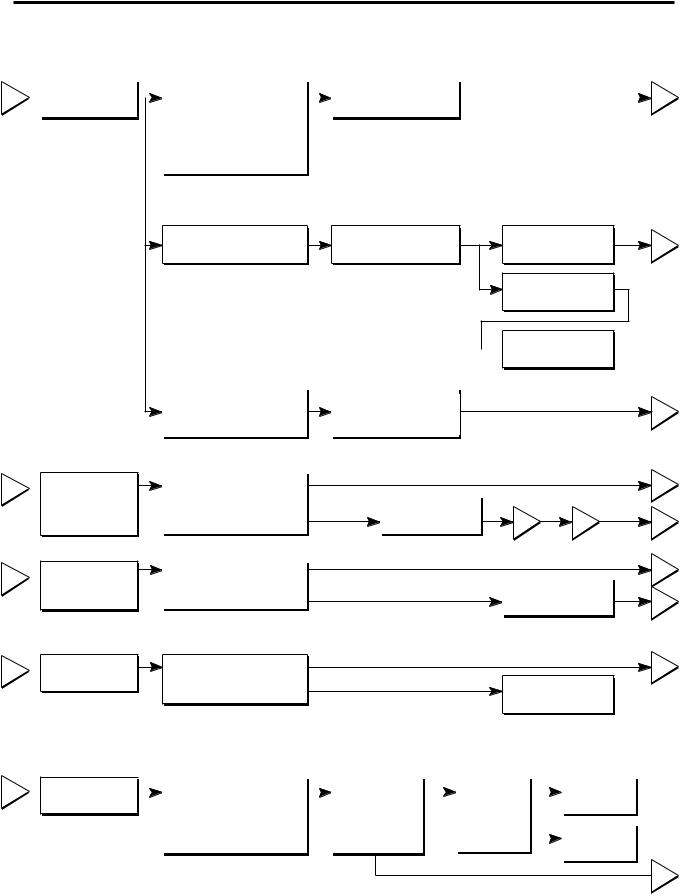
6. TROUBLESHOOTING
6-1 COMPRESSOR AND ELECTRIC COMPONENTS
1
2
3
|
|
|
Remove PTC-Starter |
|
(Reated Voltage |
YES |
|
Power Source. |
|
|
from Compressor and |
|
±10%)? |
|
2 |
|
|
|
|
|
|
||
|
|
|
measure voltage |
|
|
|
|
|
|
|
|
|
|
||
|
|
|
between Terminal C of |
|
|
|
|
|
|
|
Compressor and |
|
|
|
|
|
|
|
Terminals 5 or 6 of PTC. |
|
|
|
|
|
YES |
|
5 |
No Voltage. |
OLP disconnected? |
Replace OLP. |
|
|
NO |
Check connection |
|
|
|
condition. |
|
 Reconnect.
Reconnect.
|
Applied voltage isn't |
|
Advise customer that |
|
5 |
|
in range of Rating |
|
power supply needs to be |
|
|
|
Voltage ±10%. |
|
checked by an electrician. |
|
|
|
|
|
|
|
|
Check resistance of Motor Compressor.
Check resistance of PTC-Starter.
|
Check resistance |
|
|
The range of resistance is between 1~50W(OK) |
3 |
||||
|
|
|
|
|
|
|
|
||
|
between M-C, S-C and |
|
|
|
|
|
|
|
|
|
|
Open or short |
Replace |
|
|
|
|
|
|
|
M-S in Motor |
|
3 |
4 |
|
5 |
|||
|
Compressor. |
|
|
Compressor. |
|
||||
|
|
|
|
4.5~9 W |
|
|
|
|
4 |
|
Check resistance of |
|
|
|
|
|
|
||
|
|
|
|
|
|
|
|
||
|
two terminals in |
|
Open |
|
Replace |
|
|
|
|
|
PTC-Starter. |
|
|
|
|
5 |
|||
|
|
|
|
|
PTC-Starter. |
|
|
||
|
|
|
|
|
|
|
|
|
|
|
|
|
Not open |
4 |
Check OLP. |
Check resistance of two |
5 |
|
|
terminals in OLP. |
Open or short |
|
|
|
Replace OLP. |
Check
5
starting state.
|
|
Check the power supply |
|
Supply |
YES |
Did |
YES |
Compressor |
|
|
|
|
under load. |
|
voltage rating |
|
compressor |
|
is OK |
||
|
|
(Compressor attempting |
|
with ±10%. |
|
start? |
|
|
|
|
|
|
|
|
|
|
|
||||
|
|
to re-start after being off |
|
|
|
|
|
|
Replace the |
|
|
|
for 5 minutes). |
|
|
|
|
|
|
|
|
|
|
|
|
|
NO |
compressor |
||||
|
|
|
|
|
|
|
|
|||
|
|
|
|
|
|
|
||||
|
|
|
|
|
|
|
|
|
|
|
 1
1
NO
- 11 -
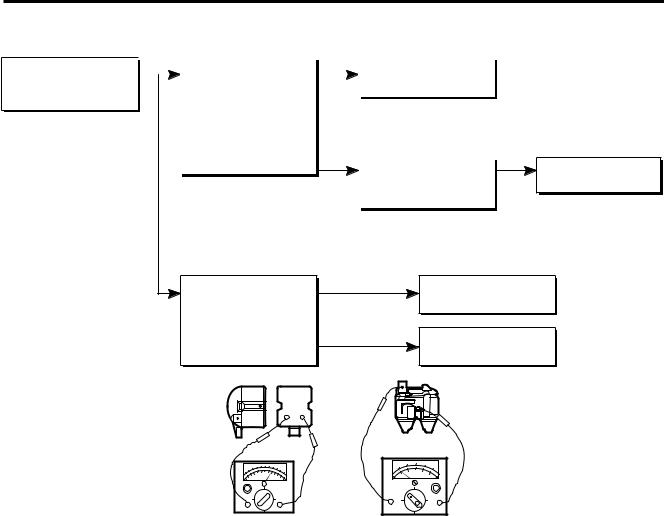
6-2 PTC AND OLP
Normal operation of
Compressor is
impossible or poor.
|
|
Separate PTC-Starter |
|
Observation value is |
|
|
from Compressor and |
|
115V/60Hz : 6.8 ±30% |
|
|
measure resistance |
|
|
|
|
|
|
|
|
|
between No. 5 and 6 |
|
|
|
|
|
||
|
|
of PTC-Starter with a |
|
|
|
|
Tester. |
|
|
|
|
(Figure 14) |
|
|
|
|
|
|
The resistance value |
|
|
|
|
is 0 (short) or |
|
|
|
|
u (open). |
|
|
|
|
|
Replace PTC-
Starter.
Separate OLP from |
|
Shows continuity |
Check another |
Compressor and check |
|
electric component. |
|
resistance value |
|
|
|
between two terminals |
Open |
|
|
of OLP with a Tester. |
|
Replace OLP. |
|
(Figure 15) |
|
|
|
|
|
|
|
6 |
5 |
|
|
Figure 14 |
Figure 15 |
- 12 -
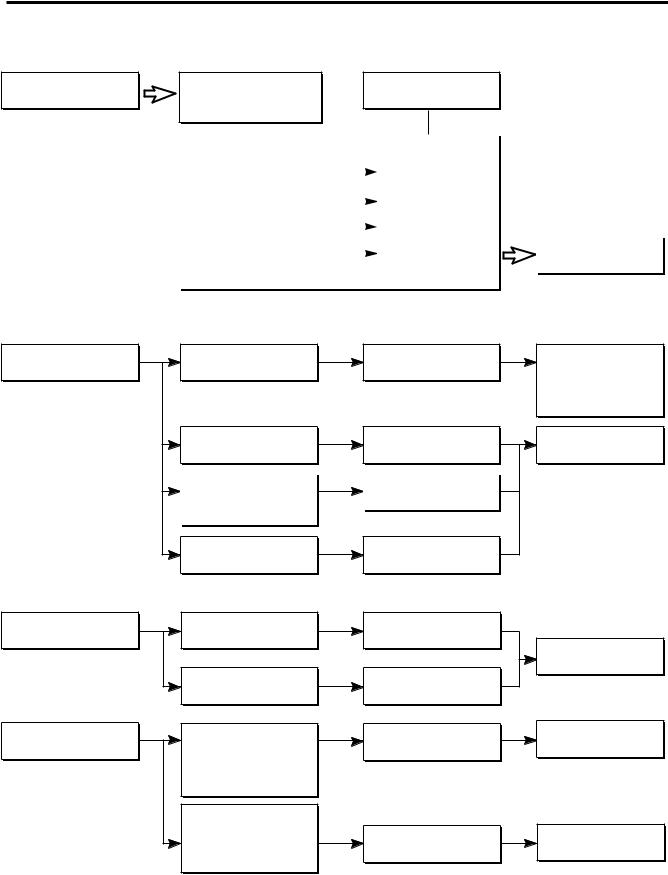
6-3 OTHER ELECTRICAL COMPONENTS
Not cooling at all
Compressor doesn't run.
Check for open short or
Cause
incorrect resistance readings in the following components
|
|
|
|
|
|
|
|
|
a. Starting devices |
|
|
Short, open, or broken. |
|
|
|||
|
|
|
|
|||||
b. OLP |
|
|
|
|
|
Poor contact |
|
|
|
|
|
|
or shorted. |
|
|
||
|
|
|
|
|
|
|
|
|
c. Compressor coil |
|
|
Coil open or shorted. |
|
|
|||
|
|
|
|
|||||
d. Wiring harness |
|
|
|
Poor contact |
|
Replace |
||
|
|
|
|
|||||
|
|
|
|
|
|
or shorted. |
|
indicated component. |
|
|
|
|
|
|
|
|
|
Poor cooling performance |
|
|
|
Compressor runs |
Check starting |
Low voltage. |
Advise customer that |
poorly. |
voltage. |
|
the Power supply |
|
|
|
needs to be checked |
|
|
|
by an electrician. |
Check voltage at |
Poor or broken or |
Replace |
starting devices. |
open contact. |
indicated component. |
|
Check current flowing |
|
Shorted. |
|
|
in sub-coil of |
|
|
|
|
Compressor. |
|
|
|
Check rating of OLP. |
Lack of capacity. |
Fan motor |
Check wiring circuit. |
Wire is open or |
|
doesn't run. |
shorted. |
||
|
|||
|
|
Replace |
|
|
|
indicated component. |
|
|
Check Fan Motor. |
Coil is shorted |
|
|
or open. |
||
|
|
Heavy frost buildup on EVAPORATOR.
Check current flow in |
Open. |
Replace |
the following |
indicated component. |
|
components: |
|
|
Sensor |
|
|
Fuse-M |
|
|
Check current flow in |
Open. |
Replace |
the Defrost Heater. |
Defrost Heater. |
|
|
|
- 13 -

6-4 SERVICE DIAGNOSIS CHART
COMPLAINT |
POINTS TO BE CHECKED |
REMEDY |
|
|
|
No Cooling. |
• Is the power cord unplugged from the outlet? |
• Plug into the outlet. |
|
• Check if the power switch is set to OFF. |
• Set the switch to ON. |
|
• Check if the fuse of the power switch is shorted. |
• Replace the fuse. |
|
• Measure the voltage of the power outlet. |
• If the voltage is low, correct the wiring. |
|
|
|
Cools poorly. |
• Check if the unit is placed too close to the wall. |
• Place the unit about 4 inches (10 cm) from the wall. |
|
• Check if the unit is placed too close to the stove, |
• Place the unit away from these heat sources. |
|
gas cooker, or in direct sunlight. |
|
|
• Is the ambient temperature too high or |
• Lower the ambient temperature. |
|
the room door closed? |
|
|
• Check if food put in the refrigerator is hot. |
• Put in foods after they have cooled down. |
|
• Did you open the door of the unit too often |
• Don't open the door too often and close |
|
or check if the door is sealed properly? |
it firmly. |
|
• Check if the Control is set to Warm position. |
• Set the control to Recommended position. |
|
|
|
Foods in the |
• Is food placed in the cooling air outlet? |
• Place foods in the high-temperature section. |
Refrigerator |
|
(front part) |
are frozen. |
• Check if the control is set to colder position. |
• Set the control to Recommended position. |
|
• Is the ambient temperature below 41°F(5°C)? |
• Set the control to Warm position. |
Condensartion or ice |
• Is liquid food sealed? |
• Seal liquid foods with wrap. |
forms inside |
• Check if food put in the refrigerator is hot. |
• Put in foods after they have cooled down. |
the unit. |
• Did you open the door of the unit too |
• Don't open the door too often and close |
|
often or check if the door is sealed properly? |
it firmly. |
|
|
|
Condensartion forms |
• Check if the ambient temperature and humidity |
• Wipe moisture with a dry cloth. It will disappear |
in the Exterior Case. |
of the surrounding air are high. |
in low temperature and humidity. |
|
• Is there a gap in the door gasket? |
• Fill up the gap. |
|
|
|
There is abnormal |
• Is the unit positioned in a firm and even place? |
• Adjust the Leveling Screw, and position the |
noise. |
• Are any unnecessary objects placed |
refrigerator in a firm place. |
|
• Remove the objects. |
|
|
in the back side of the unit? |
|
|
• Check if the Drip Tray is not firmly fixed. |
• Fix the Drip Tray firmly in the original position. |
|
• Check if the cover of the compressor enclosure |
• Place the cover in its original position. |
|
in the lower front side is taken out. |
|
|
|
|
Door does not |
• Check if the door gasket is dirty with |
• Clean the door gasket. |
close well. |
an item like juice. |
|
|
• Is the refrigerator level? |
• Position in the firm place and level the |
|
|
Leveling Screw. |
|
• Is there too much food in the refrigerator? |
• Make sure food stored in shelves does not prevent |
|
|
the door from closing. |
|
|
|
Ice and foods |
• Check if the inside of the unit is dirty. |
• Clean the inside of the unit. |
smell unpleasant. |
• Are foods with a strong odor unwrapped? |
• Wrap foods that have a strong odor. |
|
• The unit smells of plastic. |
• New products smell of plastic, but this |
|
|
will go away after 1-2 weeks. |
|
|
|
Other possible problems:
Check if frost forms in the freezer.
Check the refrigeration system.
Check the
Thermistor.
Not
defrosting
The system
is faulty.
The operation of  the Thermistor is
the Thermistor is
incorrect.
Check Components of the defrosting circuit.
Perform sealed system repair.
Replace the
Thermistor.
- 14 -
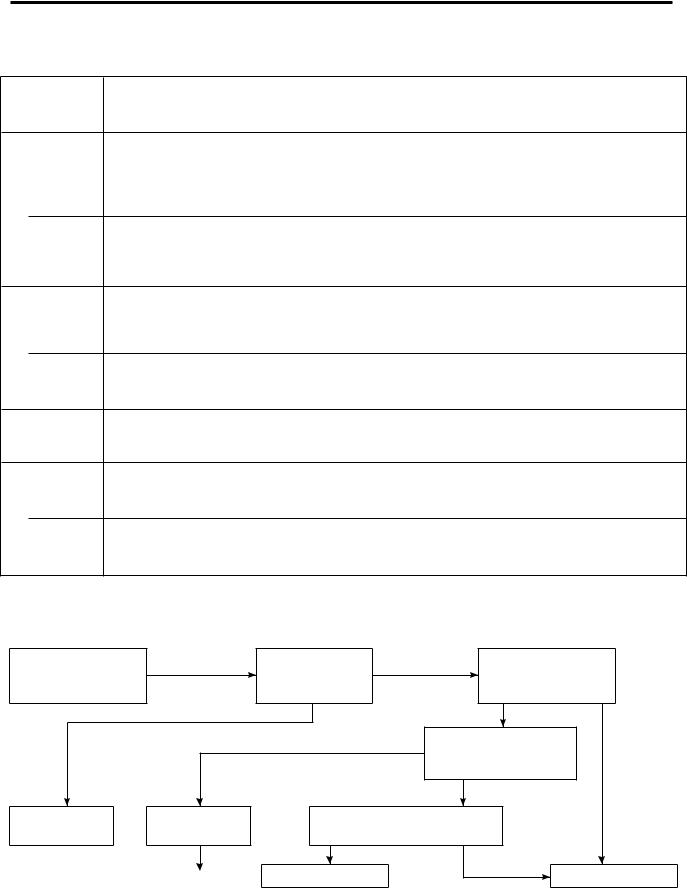
6-5 REFRIGERATION CYCLE
Troubleshooting Chart
|
|
CAUSE |
|
|
PARTIAL |
|
|
|
|
|
LEAKAGE |
LEAKAGE |
|
COMPLETE |
|
|
LEAKAGE |
BYCLOGGED |
|
PARTIAL |
|
CLOG |
|
|
|
|
DUST |
|
WHOLE |
|
CLOG |
|
|
|
|
|
|
|
|
MOISTURE |
|
|
CLOG |
|
DEFECTIVE COMPRESSION |
|
COMP- |
|
||
|
RESSION |
|
|
|
|
|
|
NO COMP- |
|
|
RESSION |
|
|
|
STATE OF |
STATE OF THE |
TEMPERATURE |
REMARKS |
|
OF THE |
||||
THE UNIT |
EVAPORATOR |
|||
COMPRESSOR |
|
|||
|
|
|
||
Freezer |
Low flowing sound of |
A little higher |
• Refrigerant level is low due |
|
compartment and |
Refrigerant is heard and |
than ambient |
• to a leak. |
|
Refrigerator don't |
frost forms in inlet only. |
temperature. |
• Normal cooling is possible by |
|
cool normally. |
|
|
• restoring the normal amount of |
|
|
|
|
• refrigerant and repairing the leak. |
|
Freezer |
Flowing sound of refrigerant |
Equal to ambient |
• No discharging of Refrigerant. |
|
compartment and |
is not heard and frost isn't |
temperature. |
• Normal cooling is possible by |
|
Refrigerator don't |
formed. |
|
• restoring the normal amount of |
|
cool normally. |
|
|
• refrigerant and repairing the leak. |
|
Freezer |
Flowing sound of refrigerant |
A little higher |
• Normal discharging of the |
|
compartment and |
is heard and frost forms |
than ambient |
• refrigerant. |
|
Refrigerator don't |
in inlet only. |
temperature. |
• The capillary tube is faulty. |
|
cool normally. |
|
|
|
|
Freezer |
Flowing sound of refrigerant |
Equal to ambient |
• Normal discharging of the |
|
compartment and |
is not heard and frost isn't |
temperature. |
Refrigerant. |
|
Refrigerator don't cool. |
formed. |
|
|
|
Cooling operation |
Flowing sound of refrigerant |
Lower than |
• Cooling operation restarts |
|
stops periodically. |
is not heard and frost melts. |
ambient |
when heating the inlet of the |
|
|
|
temperature. |
capillary tube. |
|
Freezer and |
Low flowing sound of |
A little higher |
• Low pressure at high side |
|
Refrigerator |
refrigerant is heard and |
ambient |
of compressor due to low |
|
don't cool. |
frost forms in inlet only. |
temperature. |
refrigerant level. |
|
No compressing |
Flowing sound of refrigerant |
Equal to ambient |
• No pressure in the high |
|
operation. |
is not heard and there is |
temperature. |
pressure part of the |
|
|
no frost. |
|
compressor. |
|
|
|
|
|
Leakage Detection
Observe the discharging point of the refrigerant, which may be in the oil discharging part of the compressor and in a hole in the evaporator.
Check if compressor |
YES |
Check if frost |
Check if oil |
||
forms in |
|
||||
runs. |
|
No frost |
leaks. |
|
|
|
|
|
|||
|
|
Evaporator. |
|
|
|
|
|
|
or frost forms |
|
|
|
|
|
in inlet only |
|
|
Frost formed normally |
|
Observe the discharged |
|||
|
|
|
|||
|
Normal amount |
amount of Refrigerant. |
|||
|
|
|
|
None or too much |
|
|
|
|
|
|
YES |
Moisture Clog |
Faulty |
|
Inject refrigerant in compressor |
|
|
Compressor. |
|
and check cooling operation. |
|
|
|
|
|
|
|
||
|
Check Compressor |
Clogged by dust. |
|
Gas leakage. |
|
|
|
|
|
|
|
|
|
|
Frost formed normally |
(Find the leak and repair it) |
|
- 15 -

General Control of Refrigerating Cycle
NO. |
ITEMS |
UNIT |
STANDARDS |
PURPOSES |
REMARKS |
|
|
|
|
|
|
|
|
1 |
Pipe and |
Min. |
Pipe: within 1 hour. |
To protect |
The opening time should be reduced |
|
|
piping system |
|
Comp: within 10 minutes. |
moisture |
to a half of the standards during rain |
|
|
opening time |
|
Drier: within 20 minutes. |
penetration. |
and rainy seasons (the penetration of |
|
|
|
|
|
|
|
water into the pipe is dangerous). |
|
|
|
|
|
|
|
2 |
Welding |
Nitrogen |
Weld under Nitrogen |
To protect oxide |
- Refer to repair note in each part. |
|
|
|
|
pressure |
atmosphere. |
scale formation. |
- R-134a refrigerant is more |
|
|
|
|
(N2 pressure: |
|
susceptible to leaks than R-12 and |
|
|
|
|
0.1~0.2 kg/cm2) |
|
requires more care during welding. |
|
|
|
|
|
|
- Do not apply force to pipes before and |
|
|
|
|
|
|
after welding to protect pipe from cracking. |
|
|
|
|
|
|
|
3 |
N2 sealed |
Confirm |
Confirm the sound of |
To protect |
- In case of evaporator parts, if it doesn't |
|
|
parts |
|
N2 leak |
pressure relief when |
moisture |
make sound when removing rubber |
|
|
|
|
removing the rubber cap. |
penetration. |
cap, blow dry air or N2 gas for more |
|
|
|
|
Sound: usable |
|
than 1 min. and than use the parts. |
|
|
|
|
No sound: not usable |
|
|
|
|
|
|
|
|
|
4 |
Refrige- |
Evacuation |
Min. |
More than 40 minutes |
To remove moisture. |
|
|
ration |
time |
|
|
|
|
|
Cycle |
Vacuum |
Torr |
Below 0.03 (ref) |
|
Note: Only applicable to the model |
|
|
|
||||
|
|
degree |
|
|
|
equipped with reverse flow |
|
|
|
|
|
|
protect plate. |
|
|
Vacuum |
EA |
High and low pressure sides |
|
Vacuum efficiency can be improved |
|
|
|
|
are evacuated at the same |
|
by operating compressor during |
|
|
|
|
time for models above 200 l. |
|
evacuation. |
|
|
Vacuum |
EA |
Use R-134a manifold |
To protect mixing |
The rubber pipes for R-12 refrigerant |
|
|
piping |
|
exclusively. |
of mineral and |
will be melted when they are used for |
|
|
|
|
|
ester oils. |
R-134a refrigerant (causes of leak.) |
|
|
Pipe |
EA |
Use R-134a manifold |
To protect R-12 |
|
|
|
coupler |
|
exclusively. |
refrigerant mixing. |
|
|
|
Outlet |
|
R-134a manifold exclusively. |
To protect R-12 |
|
|
|
(Socket) |
|
|
refrigerant mixing. |
|
|
|
Plug |
|
R-134a manifold exclusively. |
To protect R-12 |
|
|
|
|
|
|
refrigerant mixing. |
|
|
|
|
|
|
|
|
5 |
Refrigerant |
EA |
Use R-134a exclusively. |
Do not mix with |
- Do not weigh the refrigerant at too |
|
|
weighing |
|
Weighing allowance: ±5g |
R-12 refrigerant. |
hot or too cold an area. |
|
|
|
|
|
Note: Winter: -5g |
|
(77¡F [25¡C] is adequate.) |
|
|
|
|
Summer: +5g |
|
- Make Copper charging canister |
|
|
|
|
|
|
(Device filling refrigerant) |
|
|
|
|
|
|
Socket: 2SV Plug: 2PV R-134a |
|
|
|
|
|
|
Note: Do not burn O-ring (bushing) |
|
|
|
|
|
|
during welding. |
|
|
|
|
|
|
|
6 |
Drier |
|
|
- Use R-134a exclusively for |
To remove the |
|
|
replacement |
|
R-134a refrigerator. |
moisture from |
|
|
|
|
|
|
- Replace drier whenever repairing |
pipe inside. |
|
|
|
|
|
refrigerator cycle piping. |
|
|
|
|
|
|
|
|
|
7 |
Leak check |
|
- Do not use soapy water for |
Defect in |
- Check for an oil leak at the refrigerant |
|
|
|
|
|
check. It may be sucked |
refrigerant leak |
leak area. Use an electronic leak |
|
|
|
|
into the pipe by a vacuum. |
area. |
detector if an oil leak is not found. |
|
|
|
|
|
|
- The electronic leak detector is very |
|
|
|
|
|
|
sensitive to halogen gas in the air. It |
|
|
|
|
|
|
also can detect R-141b in urethane. |
|
|
|
|
|
|
Practice many times before using this |
|
|
|
|
|
|
type of detector to avoid false readings. |
|
|
|
|
|
|
|
- 16 -
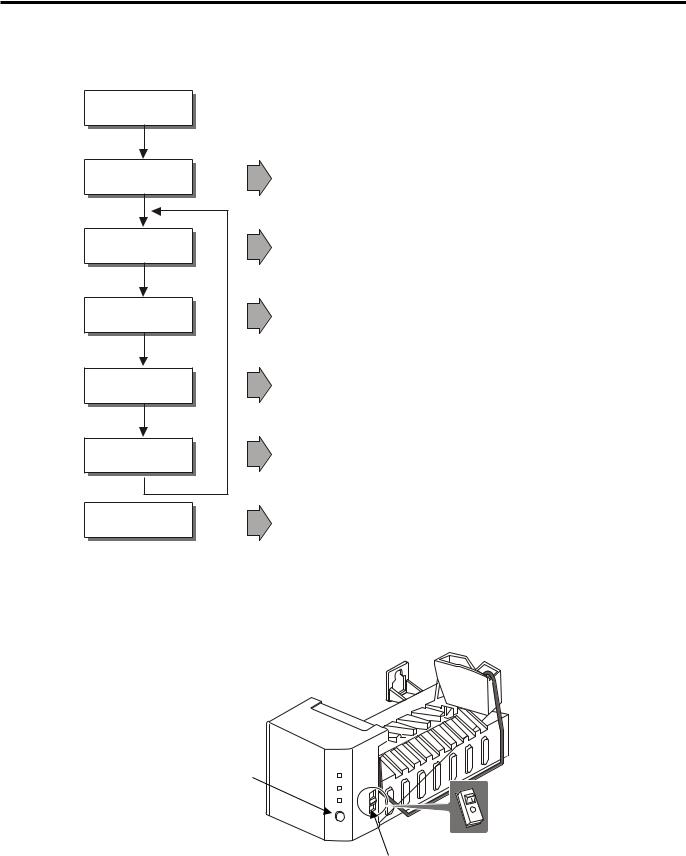
7. OPERATION PRINCIPLE AND REPAIR METHOD OF ICEMAKER
7-1 OPERATION PRINCIPLE
7-1-1 Operation Principle of Icemaker
Power On
Start Position
Icemaking |
Mode |
Harvest |
Mode |
Fill |
Park Position |
Test Mode
Adjusts Ejector to Start Position whit power on.
•Waits until water becomes cold after starting the Icemaking operation.
•Runs MOTOR to drop ice from the tray into the ICE BIN.
•Performs Icemaking Mode after supplying water by operating the SOLENOID in ICE VALVE.
•With the detect lever, checks if the ICE BIN is full.
•To operate LINE and SERVICE, press and hold the Fill Key
for 3 seconds. The icemaking will run through 3 stages:
Harvest Fill
Fill Icemaking.
Icemaking.
1.Turning the Icemaker stop switch off (O) stops the icemaking function.
2.Setting the Icemaker switch to OFF and then turning it back on will reset the icemaker control.
Water amount control button
Power (On/Off) Switch
- 17 -

7-2 ICEMAKER FUNCTIONS
7-2-1 Start Position
1.After POWER OFF or Power Outage, check the EJECTOR's position with MICOM initialization to restart.
2.How to check if it is in place:
-Check HIGH/LOW signals from HALL SENSOR in MICOM PIN.
3.Control Method to check if it is in place:
(1) EJECTOR is in place,
-It is an initialized control, so the mode can be changed to icemaking control.
(2)EJECTOR isn't in place:
A.If EJECTOR is back in place within 2 minutes with the motor on, it is being initialized. If not, go to Step B.
B.If EJECTOR is back in place within 18 minutes after the heater turns from ON to OFF, it is being initialized. If not, it is not functioning. Repeat Step B with Heater and Motor off.
7-2-2 Icemaking Mode
1.Icemaking refers to the freezing of supplied water in the ice trays. Complete freezing is assured by measuring the temperature of the Tray with Icemaking SENSOR.
2.Icemaking starts after completion of the water fill operation.
3.The Icemaking function is completed when the sensor reaches -7°C, 60 to 240 minutes after starting.
4.If the temperature sensor is defective, the ice-making function will be completed in 4 hours.
NOTE :After icemaker power is ON, the icemaker heater will be on for test for 9 seconds.
7-2-3 Harvest Mode
1.Harvest (Ice removing) refers to the operation of dropping cubes into the ice bin from the tray when icemaking has Completed.
2.Harvest mode:
(1)The heater is ON for 30 seconds, then the motor starts.
(2)After performing Step 1 (the heater is turned OFF), the ejector will be back in place wthin 18 minutes. (Hall sensor sign = OV). Ice removal is then complete. Then the icemaker cycles to the fill mode. The water supply fails to start, it is not functioning. Put the heater and motor in the off position. Restart every 2 hours. (Refer to figure1)
NOTE :If the motor malfunctions and starts before the detect lever rises, MICOM regards the Ice-Removing phase as completed. Water then starts flowing. To prevent this, MICOM doesn’t switch to water-supply mode, but restarts the iceremoving mode. If this happens 3 times, the motor is malfunctioning and you should stop the loads (heater, motor). Then restart the Ice-Removing mode every 2 hours. (See Step 2 above.)
|
|
|
|
|
|
|
|
|
|
|
Icemaking sensor temperature is 10ºC or more |
||||||||
|
|
|
|
|
|
|
|
|
|
|
Maximum 18 minutes |
||||||||
|
|
|
|
|
|
|
|
|
|
|
After detect LEVER rises |
||||||||
Heater |
|
on |
|
|
|
|
|
|
|
|
|
|
|
|
|
|
|
|
|
|
|
|
|
|
|
|
|
|
|
|
|
|
|
|
|
|
|||
|
off |
|
|
|
|
|
|
|
|
|
|
|
|
|
|
|
|
|
|
|
|
|
|
|
|
|
|
|
|
|
|
|
|
|
|
|
|
|
|
|
|
|
30 sec. |
|
|
|
|
|
|
|
|
2 ms |
|||||||
|
|
|
|
|
|
|
|
|
|
|
|||||||||
|
|
|
|
|
|
|
|
|
|
|
|
|
|
|
|
|
Ice removing |
||
Motor |
|
|
|
on |
|
|
|
|
|
|
|
|
|
|
|
||||
|
|
|
|
|
|
|
|
|
|
|
|||||||||
|
|
|
|
|
|
|
|
|
|
|
|||||||||
|
|
|
|
off |
|
|
|
|
|
|
|
|
|
|
|
completion point |
|||
|
|
|
|
|
|
|
|
|
|
|
|
|
|
|
|
|
|
||
|
|
|
|
|
|
|
10 sec. |
|
|
|
|
||||||||
|
|
|
|
|
|
|
|
|
|
|
|
|
|
|
|
|
|
|
|
|
|
|
|
|
|
|
|
|
|
|
|
|
|
|
|
|
|
|
|
|
|
|
|
|
|
|
|
|
|
|
|
|
|
|
|
|
|
|
|
5V
Hall IC
0V
Figure1. Harvest mode Process
- 18 -
